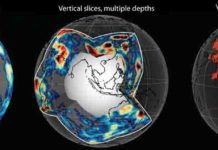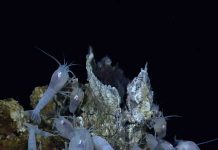
A new study led by scientists with The University of Texas at Arlington demonstrates for the first time how elemental carbon became an important construction material of some forms of ocean life after one of the greatest mass extinctions in the history of Earth more than 252 million years ago.
As the Permian Period of the Paleozoic Era ended and the Triassic Period of the Mesozoic Era began, more than 90 percent of terrestrial and marine species became extinct. Various proposals have been suggested for this extinction event, including extensive volcanic activity, global heating, or even one or more extraterrestrial impacts.
The work is explained in the paper, “High influx of carbon in walls of agglutinated foraminifers during the Permian-Triassic transition in global oceans,” which is published in the March edition of International Geology Review.
Researchers focused on a section of the latest Permian aged rocks in Vietnam, just south of the Chinese border, where closely spaced samples were collected and studied from about a four-meter interval in the boundary strata.
Merlynd Nestell, professor of earth and environmental sciences in the UT Arlington College of Science and a co-author of the paper, said there was extensive volcanic activity in both the Northern and the Southern Hemispheres during the Permian-Triassic transition.
“Much of the volcanic activity was connected with the extensive Siberian flood basalt known as the Siberian Traps that emerged through Permian aged coal deposits and, of course, the burning of coal created CO2,” Nestell said.
He noted that there was also synchronous volcanic activity in what is now Australia and southern China that could have burned Permian vegetation. The carbon from ash accumulated in the atmosphere and marine environment and was used by some marine microorganisms in the construction of their shells, something they had not done before.
This new discovery documents elemental carbon as being a major construction component of the tiny shells of single-celled agglutinated foraminifers, ostracodes, and worm tubes that made up part of the very limited population of bottom-dwelling marine organisms surviving the extinction event.
“Specimens of the boundary interval foraminifers seen in slices of rock that were ground thin and studied from other places in the world revealed black layers,” said Galina P. Nestell, study co-author and adjunct research professor of earth and environmental sciences at UT Arlington. “But nobody really checked the composition of the black material.”
Nestell said this phenomenon has never been reported although sequences of rocks that cross this important Permian-Triassic boundary have been studied in Iran, Hungary, China, Turkey, Slovenia and many other parts of the world.
For the study, Asish Basu, chair of earth and environmental sciences at UT Arlington, analyzed clusters of iron pyrite attached to the walls of the foraminifer shells for lead isotopes. Data from these pyrite clusters support the presence of products of coal combustion that contributed to the high input of carbon into the marine environment immediately after the extinction event.
Brooks Ellwood, emeritus professor of Earth and Environmental Sciences at UT Arlington and a professor in the Louisiana State University Department of Geology and Geophysics, collected the samples to study the Permian-Triassic boundary interval using magnetic and geochemical properties. He and his colleague Luu Thi Phuong Lan of the Vietnamese Academy of Science and Technology in Hanoi, Vietnam, also collected the samples used in the biostratigraphic work by the Nestells and Bruce Wardlaw of the Eastern Geology and Paleoclimate Science Center at the U.S. Geological Survey and adjunct professor at UT Arlington.
By using time-series analysis of magnetic measurements, Ellwood discovered the extinction event to have lasted about 28,000 years. It ended about 91,000 years before the actual Permian-Triassic boundary level — as defined worldwide by the first appearance of the fossil conodont species Hindeodus parvus — identification done by Wardlaw.
Galina Nestell said the high carbon levels began after the extinction event about 82,000 years before the official boundary horizon and continued until about 3,000 years after the Permian-Triassic boundary horizon. The boundary horizon is calculated to be 252.2 million years before present.
Other co-authors who contributed to parts of the study include Andrew Hunt, EES associate professor at UT Arlington, Nilotpal Ghosh of the University of Rochester; Harry Rowe of the Bureau of Economic Geology at the University of Texas at Austin; Jonathan Tomkin of the University of Illinois, Urbana; and Kenneth Ratcliffe of Chemostrat Inc. in Houston.
Reference:
Galina P. Nestell, Merlynd K. Nestell, Brooks B. Ellwood, Bruce R. Wardlaw, Asish R. Basu, Nilotpal Ghosh, Luu Thi Phuong Lan, Harry D. Rowe, Andrew Hunt, Jonathan H. Tomkin, Kenneth T. Ratcliffe. High influx of carbon in walls of agglutinated foraminifers during the Permian–Triassic transition in global oceans. International Geology Review, 2015; 57 (4): 411 DOI: 10.1080/00206814.2015.1010610
Note: The above story is based on materials provided by University of Texas at Arlington.










